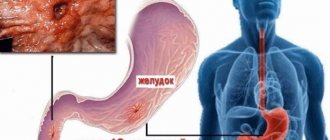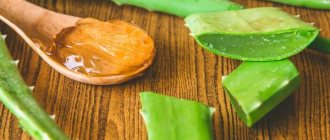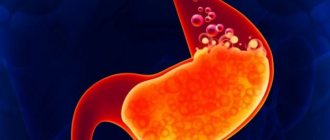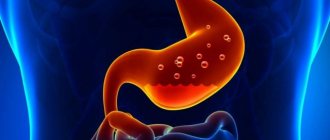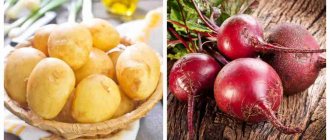Diet for stomach and duodenal ulcers is an obligatory component of complex therapy, which does not lose relevance even at the stage of stable remission. Also, such a diet, in parallel with treatment, is recommended for patients with gastritis and stomach ulcers associated with Helicobacter pylory.
Patients with stomach ulcers are prescribed a special diet - table No. 1. Dietary table No. 1 has 2 modifications: No. 1A and 1B:
- 1A - strict nutrition with limited calories, prescribed in the first 14 days of exacerbation of acute or chronic gastritis, ulcers
- illness, as well as 7 days after gastric surgery (i.e., this diet is also prescribed after a perforated stomach ulcer). Involves the consumption of all dishes in liquid, puree and porridge forms, frequent meals 6-7 times a day. Vegetables and fruits in any form are excluded, as well as bread (even from the list of permitted ones).
- 1B – a gentle diet after completing table 1A with increased calorie content. Dishes are liquid or mushy, meals are 5-6 times a day, vegetables, fruits and bread remain prohibited.
After stabilization, you can slightly diversify the menu from the list of permitted products.
General principles
Based on the principles of therapeutic nutrition, it is possible to adjust the diet and stop the progression of the disease. The basis of the diet is:
- Balanced diet. Diet does not mean fasting: the menu must be balanced, have an energy value of at least 2800-3000 kcal/day: 100 g. protein, 100 gr. fat, 400 gr. carbohydrates.
- Fractional meals. The maximum break between meals is 3 hours.
- The last meal is 2 hours before bedtime. You can drink warm milk before bed.
- Small portion sizes. Approximate volume – palms folded into a handful.
- Dietary preparation methods. Baking, boiling, steaming, blanching.
- Grinding. The priority is crushed, ground foods, which are easier to digest and assimilate.
- The temperature of the dishes is about 30-40 degrees. Hot and cold foods are unacceptable because they inhibit enzyme formation and slow down tissue repair.
- Normalization of drinking regime. Increasing daily consumption of clean water to 1.5 liters.
- Limit salt to 5-10 g. per day, which irritates the gastrointestinal mucosa and retains fluid in the body. Although in many diets it is written that salt can be consumed up to 12 grams. per day, but the less the better.
To reduce the secretion of the digestive glands during the period of remission, carbonate and sulfate mineral waters with a mineralization level of 2-6 g/l are recommended: Borjomi, Essentuki. Consume it without gases, warm, quickly.
Principles:
- Mechanical and chemical sparing: selection of foods eaten at one meal, exclusion of food that activates digestive secretion.
- Zigzag nutrition. Introducing foods from the prohibited list (within reasonable limits) for short periods of time, followed by a return to the diet menu. Used individually only in patients with stable remission, it is a kind of training for the gastrointestinal tract.
- Individuality. Common principles of nutrition are the basis on which to rely, but individual parameters must be taken into account: stage, location of the ulcer, age, body weight of the patient, concomitant diseases.
- Taking into account the time it takes to digest food. Data on the digestion time of each dish can be found online. For example, 1 glass of broth stays in the stomach for about 1.5 hours, meat - about 3 hours, legumes - about 5 hours.
Fried is prohibited, only boiled, baked or stewed.
How long to stick to the diet?
A strict diet for stomach ulcers must be followed during an exacerbation for 2 weeks (see below for more details). At the early stage of recovery, the goal of the diet is to accelerate the recovery of the gastric mucosa, and in the future, to prevent relapse. Next, a gentle diet must be followed for at least one year after the last exacerbation of the disease, but better – for the rest of your life.
Principles and rules of preparation
Soups for stomach ulcers, like any other dishes, must be prepared taking into account a certain number of rules. This will minimize the stress on an already vulnerable stomach.
Thus, when preparing soup, you need to consider the following points:
- All ingredients must be fresh;
- The base for the soup can be water, milk or herbal infusions. You cannot use rich broth on bones, meat or fish;
- Pieces of meat or fish can be added to the soup, but they must be prepared separately in advance. At the same time, you can choose only lean types of meat, for example, young lean beef or poultry;
- Minimum amount of herbs and spices. Even standard salt and pepper should be added in very limited quantities, and in case of an acute illness, it is better to abandon them altogether;
- Ban on vegetable oil. This means that it cannot be added either to the soup itself or to fry vegetables on it. Frying can greatly irritate the gastric mucosa, so vegetables should be used fresh. But a small piece of good quality butter can be added to freshly prepared soup;
- Grinding ingredients. If it is difficult for a stomach with an ulcer to digest the food consumed, then it is best to first pass all the ingredients used for the soup through a blender or meat grinder.
All ingredients for soups for ulcers must be fresh
. Of course, much depends on the patient’s condition and the severity of the disease. For example, in the remission stage, an ulcer patient may be allowed to periodically consume soups based on weak chicken broth. And, conversely, in case of particularly acute manifestations of an ulcer, the doctor may further tighten the listed rules for preparing first courses.
Ingredients to avoid include:
- Fatty meats and poultry;
- Vegetable oils, especially sunflower;
- Additives in the form of mayonnaise, tomato paste, ketchup;
- Legumes due to the fact that they provoke gas formation in the stomach. Therefore, pea soup is prohibited;
- Vegetables: white cabbage, turnips, radishes.
Any soup should always be consumed warm. Hot dishes can injure the mucous membranes of the stomach. The same applies to very cold soups, for example, dietary okroshka. If it was in the refrigerator, then it needs to be placed on the table in advance to warm up.
Another important point that must be observed is that patients with stomach ulcers should only consume freshly prepared food. This means that there is no point in preparing a large pan for future use, but it is enough to make the volume that will be sufficient for one day.
Allowed and prohibited foods for diet No. 1
A patient with a stomach and/or duodenal ulcer should remember this table: permitted foods will promote rapid regeneration of the mucous membrane, one might say, help the main therapy, while prohibited foods will nullify treatment with the most effective and expensive medications. The list of allowed foods during the diet is quite wide.
| Authorized Products | Prohibited Products |
| Low-fat meat soups with secondary broth. Meat for broth: chicken, beef, other dietary varieties. Milk soups with permitted cereals or pasta. Viscous cereal soups. Soups with vegetable broth. Puree soups. | Rich meat and fish broths (first boiling) and first courses, sauces, gravies based on them. During an exacerbation, soups with meat and fish broth are prohibited. |
| Low-fat fish, minced fish dishes: steamed, oven-baked, baked in foil. | Occasionally you can eat soaked low-fat herring. |
| Lean meat with a minimum of veins: rabbit, turkey, beef, chicken, veal. Dishes: meatballs, zrazy, cutlets, soufflé, steamed meatballs. When processing meat, you need to cut out cartilage, veins, and remove the skin from the bird. | Fatty varieties of fish, meat, as well as lard, caviar, salted fish. Mushrooms in any form. |
| Olive oil, unrefined sunflower oil, unsalted butter in small quantities. | Smoked meats, any sausages, pates. Canned foods. At the stage of stable remission, you can sometimes eat boiled sausage or mild ham. |
| Low-fat dairy products: sour cream, yogurt (preferably homemade), milk, cottage cheese, fermented baked milk. Outside of an exacerbation, fresh warm kefir is allowed, but not sour, optimally with the addition of a spoonful of vegetable oil. | Dairy products with high acidity: kefir, ayran, tan. |
| Unleavened low-fat cheeses in crushed form. Occasionally you can add cream to dishes. | Fatty dairy products: buttermilk, whole, condensed milk, cream, cheeses. |
| Soft-boiled eggs, steam omelette. You can have raw eggs, but only of proven quality (there is a high risk of salmonella infection). | Hard-boiled eggs, scrambled eggs. |
| Boiled pasta, cereals: rice, rolled oats, buckwheat, semolina. | Barley, corn, wild rice, muesli, granulated bran, millet, pearl barley, barley, corn grits, legumes. |
| Easily digestible vegetables: cauliflower, broccoli, young carrots, potatoes, zucchini, pumpkin. Occasionally, green peas and boiled beets can be introduced into the diet (as an additive to a dish). | Vegetables with a lot of hard-to-digest fiber: radishes, radishes, white cabbage, peas, turnips, rutabaga, beets (during an exacerbation period) |
| Sweet tomato varieties are limited. Cucumbers without aggravation, not a lot, without skin, chopped. Sour tomatoes are not allowed, sweet varieties are allowed without exacerbation by pouring boiling water over them and removing the skin (no more than 100 grams per day). Dill and parsley (without stems) - in small quantities without exacerbation. | Vegetables and herbs that irritate the gastric mucosa: sorrel, rhubarb, onions, garlic, sour tomatoes. |
| Non-acidic berries, fruits, baked apples and pears, bananas. Allowed fruits and vegetables should be eaten without peeling and in grated form. | Berries, fruits with acid: figs, gooseberries, currants, grapes, lemons, limes, tangerines, oranges, pineapples, watermelons. |
| Nuts, seeds, dried fruits, apricots. | |
| White milk sauce. | Hot, salty, spicy sauces: horseradish, mustard, ketchup, vinegar. |
| Desserts: marmalade, honey, marshmallows, marshmallows, jam, preserves, jelly, jelly, mousses, creams. | Chocolate, ice cream. |
| Decoctions of wheat bran, rose hips, non-acidic freshly pressed juices diluted with water 1:1, light teas, compotes. | Strong coffee, cocoa, teas. Carbonated drinks. Alcohol. Weak cocoa can be made with milk from time to time. Coffee lovers during a period of stable remission are periodically allowed weak coffee with milk, but not on an empty stomach. |
| Bread made from wheat flour is stale (a day or more after baking). | Rye bread. |
| Baking from unleavened dough without yeast in small quantities. Acceptable filling: apples, fish, lean meat, cottage cheese. Rusks, unsweetened cookies. | Baking. |
The benefits of dietary soups for stomach ulcers
First of all, you need to remember that soup itself will not save you from dehydration, which often accompanies exacerbation of gastrointestinal diseases. However, broth can be a tasty and nutritious addition to your daily fluid intake.
Vegetable first course options are rich in dietary fiber, which improves the passage of food through the gastrointestinal tract. During periods of acute pain, “empty” soup with vegetable broth will quickly satisfy the feeling of hunger without leading to a deterioration in the patient’s well-being.
Is it possible for a peptic ulcer...
Drink soda?
Many patients take soda to relieve heartburn and discomfort. Soda can neutralize the effect of hydrochloric acid, which is produced in large quantities during peptic ulcers. But a vicious circle arises: as soon as the soda leaves the stomach and goes into the duodenum, the body produces a new portion of acid in even larger quantities. In addition, when soda and hydrochloric acid interact, carbon dioxide is produced, which swells the walls of the stomach, and this is a danger of perforation. Therefore, soda is prohibited.
Smoking?
Smoking is prohibited if you have an ulcer, since tobacco smoke has an irritating effect on the gastrointestinal tract and provokes an increase in the symptoms of the disease - pain, belching, heartburn. Nicotine enters the stomach and with saliva, slows down the scarring of the ulcer, inhibits regeneration, and also irritates the mucous membrane and intestines in the same way as food, i.e. activates the production of pepsin and hydrochloric acid. If the stomach is empty, the mucous membrane will suffer from the aggressive action of gastric juice. If you smoke on a full stomach, the activity of the digestive glands and motor function will also increase, which leads to the release of gastric contents into the esophagus, especially in people with cardia deficiency. A sad statistical fact is that smokers suffer from this disease 5 times more often than non-smokers.
Smoking an electronic cigarette?
The E-cigarette, which is positioned as safe, is also prohibited. Patients who do not adhere to this advice will agree that “safe smoking” results in heartburn, belching, dryness and a sour taste in the mouth. The vapor that occurs when smoking is by no means so safe and contains many harmful substances (and, according to studies by Japanese and American scientists, carcinogens). Harmful chemicals settle in saliva and enter the stomach when swallowed.
Drink alcohol?
Some people claim that vodka, cognac and other strong drinks speed up the healing of stomach ulcers and reduce pain. However, doctors are categorical on this issue - alcohol is prohibited. Any alcohol, be it 20-year-old whiskey or cheap brandy, increases inflammation in the gastrointestinal tract, increases the acidity of gastric juice, and slows down motor function. Alcohol often causes exacerbation of the disease and provokes gastric bleeding.
Cheese
A healthy dairy product with a lot of protein and calcium can be introduced into the diet during the remission stage. Unleavened cheeses with a fat content of about 15% are allowed: ricotta, feta, Arla Oltermani, Viola Polar. But fatty varieties of cheese are prohibited.
Kefir
The fermented milk product is rich in amino acids, vitamins (water- and fat-soluble), enzymes, macroelements and minerals, therefore it has high value for the body and is quickly absorbed by the digestive system (3 times faster than milk). In the stage of stable remission, you can drink kefir: fresh, not sour (for example, for children), slightly warmed, no more than 1 glass per day. In the acute period, kefir is prohibited.
Milk
Without exaggeration, milk can be called the number one product for peptic ulcers. Milk coats the gastric mucosa, relieves pain and discomfort, and also eliminates heartburn. Pasteurized low-fat cow's milk is allowed. Nutritionists also advise patients to drink goat’s milk without heat treatment, but first dilute it by half with boiled water.
Butter
You can add oil to dishes, the main requirement is natural and fresh. With butter, the recommendation about low-fat dairy products is not relevant: you just need to buy high-quality butter with high fat content (82.5%), but use it as an additive to porridge in limited quantities. But inexpensive, low-fat oils most often contain a milk fat substitute.
Sea buckthorn oil
This useful product can be purchased at the pharmacy. Sea buckthorn has a pronounced anti-inflammatory and regenerating effect, accelerates the healing of ulcerative defects and gently envelops the mucous membrane. You can take 1-2 tbsp. sea buckthorn oil per day, before meals.
Eggs
Chicken eggs are included in the list of foods that you can eat: the protein is rich in low-calorie fats, proteins, amino acids and is quickly absorbed by the body. The yolk is rich in vitamins (D, E, A, B) and minerals and emulsifying fats. During the period of remission, you can use 2 pcs. eggs a day (D-0) soft-boiled or as a steam omelet. Raw eggs on an empty stomach are also useful - they create a protective film on the gastric mucosa, but doctors do not recommend this option of consumption, since the risk of salmonellosis infection is high. No less useful are quail eggs, which suppress pain, relieve inflammation, are completely absorbed by the body, and have an antibacterial effect. Recommendations for consumption are the same, 4-5 quail eggs per day.
Tea
During the period of remission, you can drink weak black, green tea with milk, herbal tea (if there is no allergy), you can use herbal teas from the pharmacy, which are called stomach teas. Strong black tea is rich in theophylline, which activates the production of hydrochloric acid, i.e. increases acidity and you can’t drink it when it’s strongly brewed.
Coffee
People who cannot imagine their life without an invigorating aromatic cup will have to give up coffee (natural and instant) if they are diagnosed with a stomach ulcer. A hot drink irritates the gastric mucosa and increases existing inflammation. Coffee is saturated with chemicals that cause an increase in hydrochloric acid levels. Immediately after drinking coffee, heartburn occurs, a nagging pain in the stomach. In the stage of stable remission, when the ulcer has already healed, you can drink natural coffee with milk once every 7-14 days, but not on an empty stomach. An alternative option is chicory, but, again, only with the permission of a gastroenterologist.
Nuts and seeds
Rich in vitamins, minerals, unsaturated fatty acids, seeds and nuts are prohibited at any time during the course of the disease: they irritate the stomach wall, cause heartburn and take a long time to digest. In addition, hard pieces injure the mucous membrane.
Bananas
The fruit is included in the list of permitted and even recommended products. Banana pulp envelops the gastric mucosa, improves digestion, reduces acidity, and has high nutritional value. Some researchers claim that bananas contain a substance that has a detrimental effect on Helicobacter pylori. Bananas must be ripe, preferably chopped.
Cabbage
White cabbage, including early cabbage, is contraindicated because it contains indigestible fiber, increases gas formation, irritates the mucous membrane, and slows down healing. But cabbage juice during remission is possible and even necessary!
Beetroot
The vegetable is rich in hard-to-digest fiber and contains a number of natural acids that increase the pH of gastric juice. You can’t eat beets during the acute period, but during the period of remission you can, not a lot. There is evidence of the benefits of beetroot juice, which can be carefully included in the diet, diluted with water 1:1 and in a small amount, after letting it sit for 3 hours.
Pepper
Both hot and bell peppers are prohibited. Everything is clear about hot peppers, but sweet peppers contain a substance with an irritating effect - the alkaloid capsiacin. Pepper also provokes the production of hydrochloric acid.
cucumbers
Most experts unanimously prohibit cucumbers in any form both during the period of exacerbation and during the period of remission, since they increase acidity. But in the absence of increased acidity during the period of remission, you can eat young fresh cucumbers without skin in crushed form, for example, grated on a coarse grater, no more than 200 g. per day.
Recipes
Knowing which foods are allowed for consumption and which are prohibited, you can create a varied menu for the week.
As already mentioned, the nutrition of patients with peptic ulcers should be enjoyable and their appearance should evoke appetite. To do this, it is not at all necessary to use lengthy cooking methods and look for sophisticated recipes with unclear names. Often it is quite enough to simply subject the food to the usual heat treatment, boil, bake or stew, and then put it beautifully on a plate, after which you will want to quickly try the prepared dish. To achieve this result, you can use simple, but this does not make them any less popular and interesting recipes.
Rice casserole
In this case, when preparing a casserole, it is recommended to use a multicooker; in it, the food is evenly baked, cooked well, and the resulting dish retains all its taste and beneficial properties. To prepare, you need to take one glass of rice, eggs, milk, salt and sugar, steamed seedless raisins. Pre-boil the rice in milk, selecting the “Porridge” mode, then add the beaten yolks and everything else, put it on the “baking” mode for 20-25 minutes.
Omelette
A light steamed dish will provide the body with a sufficient amount of energy, help strengthen muscle tissue, and improve metabolism.
Take three eggs and separate the white from the yolk, removing the latter. The remaining component is salted and fifty milliliters of milk is added. Everything is mixed with a mixer and sent to simmer.
Chicken dumplings with spinach
To prepare chicken fillet balls, it is first twisted through a meat grinder. For the quenelle you need to take 500 g of minced chicken. Spinach (1 bunch) is thoroughly washed, the ends of the cuttings are cut off, then finely chopped and doused with boiling water. Add 1 egg, spinach, and a little salt to the minced meat. Mix everything and form small balls. It is best to cook them in a double boiler, but you can simply simmer them in a saucepan, adding half a glass of clean water to the bottom.
Chicken baked with apples
Sprinkle chicken fillet with salt and herbs. Peel 2-3 apples and cut them into slices. Wrap everything in foil and cook in the oven for 50 minutes.
Chicken meat is tender and lean, so it will not harm the mucous membrane. It consists of fibers that absorb acid that corrodes stomach tissue. Chicken meat can be boiled or baked. It will also make an excellent light version of cutlets - steamed or stewed meatballs. A combination of boiled vegetable salads will be harmonious with meat. Apples should be taken of sweet varieties, because excess acid will have a detrimental effect on the stomach.
Vegetable salad
Salads are good for any body; for patients with ulcers, a salad made from boiled potatoes and beets is suitable. Even the most inexperienced cook can prepare it, for which you need to peel the boiled vegetables and chop them on a medium grater, add salt and any vegetable oil to the salad, you can sprinkle a little fresh herbs for decoration.
Salad with turkey and rice
Salads can diversify the menu for stomach ulcers. You can choose dietary recipes for both cold and warm salads. But it is important to remember that products such as mayonnaise, smoked meats, and sour sauces are prohibited. For salad dressings, it is best to use olive oil or sour cream with 10-15% fat content.
We suggest you try making turkey salad with rice. It has a mild taste and is easy to prepare:
- Turkey fillet needs to be boiled, then cooled and cut into strips;
- long grain rice is boiled and washed;
- fresh cucumber is peeled and grated on a coarse grater;
- hard-boiled quail eggs, cut into quarters;
- All components are mixed and seasoned with low-fat sour cream.
Fruit pudding
For preparation, semolina, milk, apples or pears, at least two eggs, sugar, and butter are used. While boiling, pour semolina into the milk in a thin stream; vanillin can be added. After the porridge has cooled, add butter softened at room temperature and 2 yolks, mashed with powdered sugar. Finely chopped fruits are added to the finished dish.
Curd dessert with bananas
To prepare a curd dessert, mix 1 pack (200 g) of cottage cheese with 1 egg and 1 tablespoon of sugar. Cupcake molds are used for baking. Bananas cut into slices are laid out on their bottom, and one and a half tablespoons of curd-egg mixture are placed on top. The forms are sent to a preheated oven for 15-20 minutes.
During the period of exacerbation of the disease, you must strictly follow the menu compiled by the doctor for a week, and under no circumstances consume irritating foods. For stomach ulcers in the healing stage, you can test recipes with an expanded list of ingredients. However, it is important not to overeat, not to overload the stomach even with foods that are safe for it. Following nutritional recommendations will speed up recovery and reduce stomach discomfort.
Carrot pudding
To prepare this dish you will need:
- carrots – 2 pcs.;
- sour apples – 2 pcs.;
- cottage cheese – 50 g;
- egg – 1 pc.;
- sugar – 15 g;
- sour cream - 1 tbsp;
- semolina – 2 tbsp.
Semolina and grated apples without peel are added to the chopped carrots. The cottage cheese is ground through a sieve and sent to the mass. Add the remaining ingredients there and mix thoroughly.
Separately, beat the egg whites with a pinch of salt to sharp peaks and mix into the curd mixture. Form balls and send them to cook in a water bath for about 20 minutes. Delicious and healthy pudding is ready!
Berry soufflé
Soufflé with berries is prepared from the following ingredients:
- any sweet berry (raspberry, strawberry) – 0.5 cups;
- sugar – 1-2 tbsp;
- egg white – 3 pcs.
Fresh berries are washed well and ground through a sieve. The resulting mass is diluted with sugar and salt is added (optional). Then cook over low heat until thick.
Beat the egg whites well and then combine with the cooled berry mixture. The resulting mass is placed in small molds greased with oil. Bake in the oven for 15 minutes at 180 degrees.
Currant jelly
Preparing this dish is not difficult; you only need a minimum amount of ingredients:
- currants (fresh or frozen) – 2 tbsp;
- gelatin, sugar - 1.5 tsp each.
To begin with, juice is squeezed out of the berries, which is then put in the refrigerator. While the juice is cooling, prepare gelatin as indicated in the instructions on the package. The berry pulp remaining after squeezing is put on fire and boiled for 15 minutes. The resulting broth is filtered and cooled. Then sugar is dissolved in it and heated again over the fire until it boils.
The boiling process is accompanied by the formation of foam, which must be removed. Then add diluted gelatin into the mixture and mix thoroughly. Take the cold juice out of the refrigerator and add it to the mixture. The last stage is to pour the syrup into molds and put it in the refrigerator for several hours. Ready jelly can be consumed after 3-4 hours.
Products that have a healing effect
There are three products available that have a healing effect.
- Fresh potato juice. A simple superfood that can be used for healing. It has regenerating, wound-healing, analgesic, and anti-inflammatory effects. Potato juice also destroys pathogenic flora that is present in the stomach. Prepare juice from fresh, high-quality potatoes and drink immediately. Take outside the period of exacerbation, half an hour before meals, for 3 weeks in a row. Volume: start with a few spoons, increase to 150 ml per day. It is better to take it diluted with water, 1:1.
- Low fat milk. Envelops the walls of the stomach, protects the organ from the aggressive effects of foods and gastric juice, accelerates the regeneration process, dulls or even relieves pain.
- Honey. You can eat honey in small quantities every day: the product is rich in microelements, vitamins, and has a beneficial effect on the entire gastrointestinal tract. As for the ulcerative process, honey helps relieve inflammation, reduces secretion, neutralizes the effect of hydrochloric acid, and relieves pain. Honey reduces nausea and heartburn inherent in the disease, and increases the level of hemoglobin in the blood.
- Fresh cabbage juice. Contains a stable form of ascorbic acid and anti-ulcer vitamin U. The juice has been proven to be effective in accelerating wound scarring and against Helicobacter pylory.
They can be included in the list of dishes, the only caveat is about cabbage juice: you can drink it freshly prepared, diluted with water (1:1), no more than 100 ml at a time, 2-3 times a day. The most important thing is only during the period of remission!
What soups are allowed for ulcers?
Gastroenterologists allow the consumption of any dietary soup cooked without adding fat, hot and spicy spices. Chicken broth is considered the best choice for people suffering from stomach problems. The liquid dish contains a maximum of nutrients and also strengthens local immunity. During the period of remission, when you are allowed to eat a little meat, chicken will be the best choice.
Advice from a gastroenterologist! Before starting cooking, be sure to remove the chicken skin, as it is a source of harmful fat.
If you plan to make soup from homemade chicken, then you will have to spend several times more time on cooking. The meat will need to be separated from the bones, finely chopped, and returned to the broth.
Potato soup will be an excellent choice if you have a diagnosed duodenal ulcer. A properly cooked root vegetable will help absorb excess liquid and also promote accelerated healing of damaged walls. Due to the high starch content, a sticky film forms in the stomach and intestines, which, however, is digested quite quickly.
If a peptic ulcer leads to too intense pain, then you should not eat first courses with solid particles in the composition. On the first day after an exacerbation, you can prepare rice broth (essentially, it is a slimy substance obtained after a long cooking of cereals). The dish is not very tasty and nutritious, but quickly relieves pain in the gastrointestinal tract. The main thing is to consume no more than 200 ml of soup every 3 hours.
Approximate seven-day menu for the period of remission
A weekly menu for stomach and duodenal ulcers will allow you to plan your diet in advance and purchase the necessary products. A diet at home can also be compiled with the inclusion of other dishes prepared from permitted products and taking into account the principles described above.
Monday
- Breakfast: Pumpkin and cottage cheese casserole. Green tea.
- Second breakfast: Apple baked with honey.
- Lunch: Fish soup with cod and vegetables. Rabbit zrazy in white sauce. Carrot salad with herbs and sour cream.
- Afternoon snack: Vitamin jelly. Crackers.
- Dinner: Diet risotto. Turkey aspic.
- Late dinner: A glass of warm non-sour kefir.
Tuesday
- Breakfast: Semolina porridge. 2 soft-boiled eggs. Weak tea.
- Second breakfast: Sour cream pudding. 1 banana.
- Lunch: Puree soup of zucchini and potatoes. Steamed chicken cutlets with vermicelli.
- Afternoon snack: Cottage cheese soufflé.
- Dinner: Steamed pike perch with carrots in sour cream sauce. Baked apple.
- Late dinner: A glass of warm milk.
Wednesday
- Breakfast: Steamed cheesecakes. Milk jelly.
- Second breakfast: Mashed buckwheat porridge. Weak tea.
- Lunch: Noodle soup with vegetable broth. Fish pate with oatmeal porridge. Apple mousse.
- Afternoon snack: 1 glass of warm milk. 2 crackers.
- Dinner: Potato and carrot salad.
- Late dinner: Fruit jelly and natural yogurt.
Thursday
- Breakfast: Rice porridge with milk. Apple compote.
- Second breakfast: Baked pear with natural yogurt.
- Lunch: Pilaf of boiled rice with boiled beef. Apples and pears boiled in syrup.
- Afternoon snack: Unsweetened cookies. A glass of fermented baked milk.
- Dinner: Jellied turkey. Steamed vegetables. Berry jelly.
- Late dinner: A glass of warm fermented baked milk.
Friday
- Breakfast: Semolina porridge with fruit jam. Berry compote.
- Second breakfast: Cottage cheese with honey. Oatmeal jelly.
- Lunch: Rice soup. Rabbit soufflé with pumpkin puree.
- Afternoon snack: Apple and rolled oats pudding.
- Dinner: Potato and cauliflower casserole with cheese. Steamed fish cutlets.
- Late dinner: A glass of warm milk.
Saturday
- Breakfast: Steam omelette made from two eggs. Strawberry jelly.
- Second breakfast: A glass of warm fermented baked milk. Marshmallow.
- Lunch: Chicken soup with broken rice. Steamed veal meatballs and broccoli puree. Rose hip decoction.
- Afternoon snack: Lazy dumplings with cottage cheese.
- Dinner: Crispy barley porridge with boiled meat. Wheat bran decoction.
- Late dinner: Warm tea with milk.
Sunday
- Breakfast: Milk soup with noodles. Cocoa with milk.
- Second breakfast: One soft-boiled egg. Warm tea with savory cookies.
- Lunch: Soup with turkey and vegetables. Zucchini stuffed with meat.
- Afternoon snack: Protein biscuit with jam.
- Dinner: Mashed potatoes. Boiled tongue. Cocktail of non-acidic kefir with strawberries.
- Late dinner: Glass of yogurt.
The menu for stomach ulcers is developed by the doctor, taking into account the severity and characteristics of the disease. The given menu is the basic one, which is relied upon when compiling the main menu. Recipes for each dish can be found on the Internet.
Diet features
The purpose of dietary nutrition for diseases of the digestive tract is to reduce the load on the stomach and intestines and to ensure protection of the inflamed mucous layer from external influences. Products for the patient’s diet are selected in such a way that they cannot damage the inner surface of the digestive organs.
Food should be soft enough so as not to injure the mucous membrane and be quickly absorbed. In this regard, for stomach and duodenal ulcers, dishes such as soups and semi-liquid porridges are recommended. To facilitate digestion, the products in them are crushed or ground.
Additionally, food should not cause the release of hydrochloric acid, as it corrodes the walls of the stomach and intestines, leading to the formation of ulcers.
All fried foods, as well as spicy, salty, pickled and smoked foods, are excluded from the patient’s menu. You should not drink carbonated drinks and coffee, as they provoke the release of hydrochloric acid.
Allowed to eat:
- slimy soups made from ground products;
- liquid porridges cooked in water;
- meat and fish of lean varieties, minced;
- fermented milk products, as well as cheese, cottage cheese, sour cream, milk;
- boiled, baked or steamed vegetables;
- eggs in the form of an omelet;
- fruits in the form of jelly, jellies, mousses, jams;
- pates and sauces prepared without the use of spices and prohibited products.
As for bakery products, it is allowed to eat day-old white bread and biscuits. It is recommended to drink jelly, herbal teas, fruit drinks, and raw vegetable juices in small quantities.
Despite the fact that some foods for peptic ulcers are removed from the menu, the diet remains quite extensive. There are a large number of recipes that allow you to prepare delicious and healthy first courses.
Diet during exacerbation
As we have already said, the diet for exacerbation of a stomach ulcer is table 1A, and then 1B (Pevzner tables).
Diet No. 1A
Diet for the acute period of an ulcer, which will have to be followed for 1-2 weeks. If we are talking about exacerbation of gastritis, the diet is followed for 2 to 7 days. Bed rest is mandatory. Goals:
- reduce the severity of the inflammatory process;
- accelerate the restoration of the gastrointestinal mucosa;
- reduce the excitability of stomach receptors.
The diet during an exacerbation is very gentle; the basis of the diet is pureed dishes and products boiled in water or steamed (also pureed or porridge-like, pureed). The temperature of the dishes is 30-40 degrees. The calorie content of the menu is reduced to 1800-2000 Kcal per day by reducing carbohydrates to 200 g, proteins to 80 g. (65-70% animals) and fats up to 80 g. (20% plant based). It is better to eliminate salt completely (maximum – 8 grams per day).
In case of exacerbation, give preference to boiled porridges, low-fat meat and fish soufflés, purees, and steamed omelettes.
Here are the allowed dishes. And everything that is not permitted is prohibited, and strictly and without reservations.
Allowed dishes:
- slimy cereal (pureed) or milk soups, flour soups;
- 5% porridge with water/diluted milk, optionally crushed cereals for baby food (buckwheat, rice, semolina);
- minced lean meat, in the form of steam soufflés, purees (from rabbit, veal, chicken and turkey without skin);
- low-fat fish (soufflé, puree);
- sweet juices from non-irritating fruits, diluted 1:1 with boiled water;
- scrambled eggs;
- curd soufflé;
- steam omelette;
- tea with milk is not strong;
- sweetened rosehip decoction;
- a small amount of butter in dishes;
- vegetable oil;
- milk - as an additive to dishes;
- milk jelly;
- pureed vegetables in dishes (in soup), for example, from jars of baby food. Please note that dishes and side dishes made from vegetables are excluded;
- decoction of wheat bran.
Diet No. 1B
Assigned immediately after the completion of table 1A. Complied with for a period determined by the doctor, usually 1-2 weeks, then move on to table No. 1. The entry of irritants into the gastrointestinal tract is also limited. The energy value is increased to 2900 Kcal, only carbohydrates are reduced to 300 g, the amount of proteins and fats is 90-95 g per day.
Soup recipes for stomach and duodenal ulcers
The rules for preparing dietary soups are generally indicated in each recipe. As mentioned above, it is necessary to avoid artificial flavor enhancers and prohibited foods. Otherwise, you can experiment (especially during an exacerbation period).
- Vegetable puree soup recipe.
Vegetable puree soup is allowed for both high and low acidity. It's quick, easy to prepare, and the set of ingredients itself is inexpensive.
Ingredients:
- 1 tablespoon refined vegetable oil;
- 1 onion;
- green onion stems;
- 2 large potato tubers;
- 2 large carrots;
- 1 small celery root.
- salt to taste.
Pour oil into the bottom of a thick-walled cauldron. Add finely chopped onion and sauté for two minutes. Add the rest of the vegetables (finely chopped), add water (3 liters for the specified amount of ingredients). A small amount of salt is also allowed, but during periods of exacerbation it is better to avoid the seasoning. Cook the soup for 40-50 minutes, stirring the contents of the cauldron periodically. As soon as the finished contents of the cauldron have cooled a little, puree the vegetables until you get a homogeneous mass without lumps.
- Cereal soup recipe
Recipes for cereal soups for stomach ulcers should not be confused with mucus soups. In the first case, the resulting dish has a relatively coarse consistency, while slimy soups can be consumed without problems even during an exacerbation of a peptic ulcer. The recipe below is suitable for people with low and high acidity.
Ingredients:
- wheat cereal: 1/2 cup;
- chopped carrots: 50 grams;
- finely chopped onion: 15-20 grams;
- oregano (any other dry herbs without additives) 1/4 tsp;
- vegetable oil: 2 tsp.
Sort and rinse the cereal, add a small amount of water and set aside. Heat oil in a frying pan, add onion and lightly fry. Add carrots and saute until softened (5-7 minutes). Then add a small amount of salt, dry herbs, stir and remove the pan from the heat.
While cooking the vegetables, the cereal should swell a little. It is necessary to rinse it again, pour it into a clean pan, and fill it with water (about 2-2.5 liters will be needed for the indicated amount). Bring the water to a boil, cook the cereal for 10-15 minutes, then add the vegetables, stir the contents, and keep the pan on the fire for another 15 minutes.
During cooking, the cereals and vegetables will soften sufficiently. But if you want to completely protect yourself from possible irritation of the stomach walls, then you can additionally grind the thick of the soup through a sieve.
Advice from a gastroenterologist! For those who suffer from high acidity, you can cook the soup not with water, but with milk.
- How to make slimy soup?
Mucous soups have a beneficial effect on the healing of ulcers and can be consumed at any acidity level. It’s quite difficult to call a slippery mass a tasty dish. But such soup can be included in the menu from the day of the exacerbation. You just need to fill the cereal (preferably oatmeal) with water. For 100 grams of oatmeal you will need at least a liter of water. Place over low heat and simmer until the contents of the pan resemble jelly. You need to periodically add water so that you don’t end up with ordinary porridge.
As soon as the unpleasant pain in the stomach disappears, you can begin to prepare more nutritious cereal soups with the addition of vegetables.
Ingredients for preparing vegetable soup with Artek cereals:
- 100 g of Artek cereal;
- 2 small onions (finely chopped);
- 1 medium-sized zucchini (without skin and seeds, finely chopped);
- head of cauliflower (no more than 100 grams).
In a Teflon-coated frying pan (allowing you to cook vegetables without oil), soften the onion. Saute the zucchini in the resulting juice. Boil cauliflower in a separate saucepan. As soon as the broth is ready, pull out the head itself, cool and finely chop. Add cereal to the broth and cook for 15-20 minutes, then add prepared vegetables. The soup can be consumed after another 15 minutes of cooking.
Pros and cons of diet No. 1
From a medical point of view, the diet has no disadvantages. Gastroenterologists recommend it for various gastrointestinal diseases - as practice shows, such a diet reduces the load on the digestive system, speeds up recovery and improves well-being. The correct diet allows you to take control of the disease, i.e. live fully with a chronic disease and minimize drug therapy.
A very conditional disadvantage is the fact that certain foods and drinks must be abandoned, but patients who have at least once experienced an exacerbation of an ulcer due to a diet failure and have known all the “delights” of this condition can easily make the right choice. Of course, you will have to cook for yourself separately from the whole family, think through the menu and diet, but this is also a gainful endeavor: 2-3 weeks, and such nutrition will become the norm of life!
Author:
Sabuk Tatyana Leonidovna hygienist, epidemiologist

